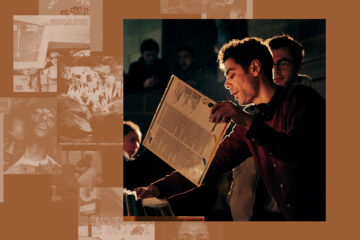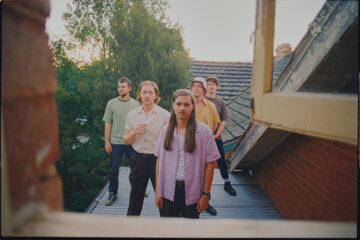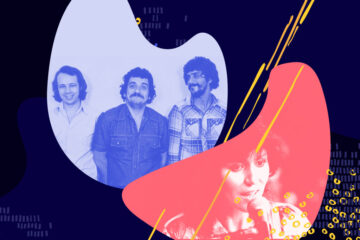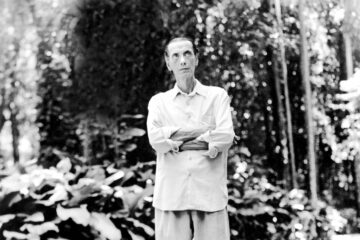One would speak of a »wunderkind« round here. When Hōzan Yamamoto started playing the Japanese bambus flute Shakuhachi, the coldly calculated genocide of the US in Hiroshima and Nagasaki was little more than a year old. The dust hadn’t settled yet, in large parts of the south of Japan hundreds of thousands civilians were melting away into a slow death, as little Hōzan was sending meditative sounds from his wooden lenthwise flute over the land, first evoked by zen-Buddhist monks hundreds of years ago.
First instructed by his father, then by a still totally unknown flutist who goes by the name of Chōzan Nakanishi, Yamamoto was working on perfecting his skill on that instrument, studied at Junior College Of Foreign Studies as well as Seiha Music College in Tokyo. How he got to prominence in his homeland as well as overseas with Tony Scott’s seminal ethnojazz gem »Music For Zen Meditation« (1964) was as history-carged as it was inevitable. Like never before, new age was fused with Japanese sōkyoku, the minimalism of the west correlated with the airworthy harmonies of the far east. Six years before that, Yamamoto already visited the World Folk Music Festival of UNESCO, distinguished himself as one of the avantgarde players in the realm of trans-pacific bridge building and played with Ravi Shankar, Chris Hinze, Gary Peacock or Helen Merrill on a number of albums – as well as live on stage.
Beautiful Bamboo-Flute
Right from the beginning, he was open for sounds beyond his own culture and their protagonists – a fascination lasting for all his life. With Nobuo Hara and his Sharps & Flats he realized the big band album »Sharps & Flats In Newport« (1967) as well as »New Dimensions Of Bamboo Flute« (1968), interweaving fusion with folk, bossa nova with funk and anticipating or at least inspiring already in the mid 60s what would later become en vogue in large parts of the western jazz world – whether subsumed under spongy terms like »ethno jazz«, »world jazz« or »world music«.
Highlight of this early creative period – consensus will tell – was the dreamy grooving »Beautiful Bamboo-Flute« (1971), on which the 34 years old Yamamoto presented his most concise compositions to date. Establishing a sound aesthetic between the new age vibe of the dawning decade as well as the scores of exploitation chanbara cinema during the previous decades, the album is a lesson in cross-cultural soundscapes: Chicago meets the subursb of Tokyo, a somatic wind section elevates the whispering and singing compass of the shakuhachi, traditionally made out of the roots end of the Madake bambus from the 17th until the 19th century by the Fuke wandering monks, who used it as a psychic tool for strictly regulated purposes – no means for fun but a key to enlightenment.
Far more than 100 releases
Beginning in the mid 70s, Yamamoto was revered and honoured with many prices, among them the prestigous 1977 Odaka award and later on the title »living national treasure«, granted by the government of Japan and many music historians alike. With luminaries of traditional Japanese music like the couple Tadao and Kazue Sawai or the jazz reformer Takeshi Inomata he covered J.S. Bach (»J.S. Bach Is Alive And Well And Doing His Thing On The Koto«, 1971) and recorded unique fusion on the creatively broad invested collabo album »Jazz-Rock« (1973). The lust for aesthetic crossovers remained a lifelong passion in the works of the restless virtuoso, who rocked minds when he went on stage with his trio Shakuhachi Sanbon Kai at the 1980 Donaueschinger Musiktage in Germany and later on was even engaged for film soundtracks such as »Makai Tenshō« (1981).
During the mid 80s his trans-cultural experiments continued and in 1985 Yamamoto encountered a musical soulmate in a rather unexpected part of the world. Together with the Heidelberg-born free jazz pianist and vibraphonist Karl Hans Berger he recorded the fusion gem »Again And Again« (1985) for Victor Record, once again evoking meditation out of improvisation. Despite his work spanning well over a hundred releases, the delicate vibrati of his instrument find an equal counterpart in the well-balanced yet varied play of Berger, who is leading or accompanying the melodies like a dancing partner. It’s a trademark many of Yamamoto’s records share: Even when the intonation of his flute is as pearly as it is airy, the head of the Hozan-kai Shakuhachi Guild keeps a certain understatement, never letting his melodic ease overexcite, even when he operates in totally alien musical realms.
Flamenco, Country, House Music
Those he seeked to explore over and over again. Excourses into the world of flamenco and folk, towards country and church music, made not only him but the Shakuhashi as his instrument more known and consequently popular in the West. Together with Chano Dominguez and Javier Paxariño its idyllic wind timbre reached for Spain (»Otoño«, 1998) while after the impressive collaboration with Wolfgang Mitterer (»Masters Of Zen: Shakuhashi And Organ, 1998) German listeners got excited and later on even contemporary DJ mixes, from pop to hip-hop and house, used the style of the flute zen-master for their sound – more often than not without giving him any credit for it. While being venerated as a national icon among younger generations in Japan for his craft, Yamamoto still remains an insider’s tip in Europe or the US, not even famed in the circles of notorious discogs diggers. When he died on february 10th 2014 in a Tokyo hospital, naturally nobody took notice in our part of the world. What remains of him is music which can be thoroughly cherished as an unexpected summer soundtrack, not just by dedicated jazz afficionados.










